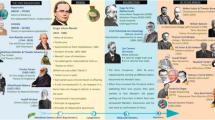Abstract
In the first decade of the twentieth century, the foundation for the science of genetics was set. In 1900, the data of Gregor Mendel were rediscovered. By 1915, a community of scientists accepted that there were entities on chromosomes that controlled the development of observable traits. During the intervening period, Thomas Hunt Morgan was one of the major skeptics regarding the chromosomal location of the genes. His acceptance may have been the turning point for the flowering of American genetics. This paper will discuss the reasons for Morgan's recalcitrance, his conversion to belief, and the nature of the scientific evidence that led to his acceptance.
Similar content being viewed by others
References
T. H. Morgan, “Chromosomes and Heredity”, Amer. Nat., 44 (1910), 449–496.
T. H. Morgan, “Chromosomes and Heredity”, Amer. Nat., 44 (1910), p. 453.
T. H. Morgan, “Chromosomes and Heredity”, Amer. Nat., 44 (1910), p. 461.
T. H. Morgan, “Chromosomes and Heredity”, Amer. Nat., 44 (1910), p. 463.
T. H. Morgan, “Chromosomes and Heredity”, Amer. Nat., 44 (1910), p. 467.
T. H. Morgan, “Chromosomes and Heredity”, Amer. Nat., 44 (1910), p. 467.
T. H. Morgan, “Chromosomes and Heredity”, Amer. Nat., 44 (1910), p. 467.
J. Maienschein, “What Determines Sex? A Study of Converging Approaches, 1880–1916”, Isis, 75 (1984), 457–480.
L. Doncaster and G. H. Raynor, “On Breeding Experiments with Lepidoptera”, Proc. Zool. Soc. London, 1 (1906), 125–133; C. E. McClung, “The Accessory Chromosome - Sex Determinant?” Biol. Bull. 3 (1902), 43–84.
Morgan, “Chromosomes and Heredity”, p. 493.
Ibid.
W. E. Castle, “The Heredity of Sex”, Bull. Mus. Comp. Zool., 40 (1903), 189–218.
Morgan, “Chromosomes and Heredity”, p. 495.
Ibid., p. 488.
T. H. Morgan, “Hybridization in a Mutating Period in Drosophila”, Proc. Soc. Exptl. Biol. Med., 7 (1910) pp. 160–161; idem, “Sex-Limited Inheritance in Drosophila”, Science, 32 (1910), 120–122.
T. H. Morgan, F. Payne, and E. N. Browne, “A Method to Test the Hypothesis of Selective Fertilization”, Biol. Bull., 18 (1910), 78.
T. H. Morgan, “The Method of Inheritance of Two Sex-Limited Characters in the Same Animal”, Proc. Soc. Exp. Biol. Med., 8 (1910), 17–19.
T. H. Morgan, “The Application of the Conception of Pure Lines to Sex-Limited Inheritance and to Sexual Dimorphism”, Amer. Nat., 45 (1911), 76–77 (emphasis added).
F. A. Janssens, “Spermatogénèse dans les Batraciens: V. La théorie de la chiasmatypie: nouvelle interprétation des cinèses de maturation”, Cellule, 25 (1909), 389–406.
Garland E. Allen, Thomas Hunt Morgan: The Man and His Science (Princeton: Princeton University Press, 1978), p. 159.
Janssens, “Chiasmatypie”, p. 400.
Ibid., p. 401 (italics in original).
Morgan, “Chromosomes and Heredity”, p. 463.
Janssens, “Chiasmatypie”, p. 406.
H. J. Muller, “Thomas Hunt Morgan 1866–1945”, Science, 103 (1946), 550–551.
A. H. Sturtevant, “Thomas Hunt Morgan 1866–1945”, N.A.S. Biog. Mem., 33 (1959), 294 (reprinted by Columbia University Press).
Allen, Morgan, pp. 152–153.
Ibid., pp. 160–161.
N. Roll-Hansen, “Drosophila Genetics: A Reductionist Research Program”, J. Hist. Biol., 11 (1978), 159–210.
S. F. Gilbert, “The Embryological Origins of the Gene Theory”, J. Hist. Biol., 11 (1978), 307–351.
J. A. Moore, “Thomas Hunt Morgan - The Geneticist”, Amer. Zool., 23 (1983), 855–865. Morgan's 1911 American Naturalist paper is not cited by Moore. Moore makes some of the same points I make, but I was not aware of his work until after the present communication had been informally presented.
Muller, “Morgan,” p. 550.
T. H. Morgan, The Physical Basis of Heredity (Philadelphia and London: J. B. Lippincott, 1919), p. 112.
Morgan, “Application of Pure Lines to Sex-Limited Inheritance,” pp. 77–78.
W. S. Sutton, “The Chromosomes in Heredity,” Biol. Bull., 4 (1903), 231–251.
W. S. Sutton, “The Chromosomes in Heredity,” Biol. Bull., 4 (1903), pp. 235–236.
Ibid., p. 238.
W. S. Sutton, “The Chromosomes in Heredity,” Biol. Bull., 4 (1903), pp. 240–241.
T. H. Morgan, Heredity and Sex (New York: Cornell University Press, 1914), pp. v-vi.
Author information
Authors and Affiliations
Rights and permissions
About this article
Cite this article
Lederman, M. Research note: Genes on chromosomes: The conversion of Thomas Hunt Morgan. J Hist Biol 22, 163–176 (1989). https://doi.org/10.1007/BF00209607
Issue Date:
DOI: https://doi.org/10.1007/BF00209607



